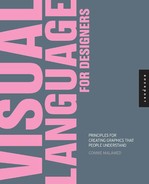0%
20Chapters
0-1Hours read
0kTotal Words
Book Description
Within every picture is a hidden language that conveys a message, whether it is intended or not. This language is based on the ways people perceive and process visual information. By understanding visual language as the interface between a graphic and a viewer, designers and illustrators can learn to inform with accuracy and power. In a time of unprecedented competition for audience attention and with an increasing demand for complex graphics, Visual Language for Designers explains how to achieve quick and effective communications. It presents ways to design for the strengths of our innate mental capacities and to compensate for our cognitive limitations.
Table of Contents
- Cover
- Title Page
- Acknowledgments
- Contents
- Introduction
- Section One: Getting Graphics
- Section Two: Principles
- Bibliography
- Glossary of Terms
- Sources Cited
- Directory of Contributors
- Dedication
- Copyright
